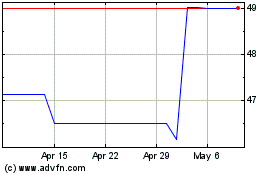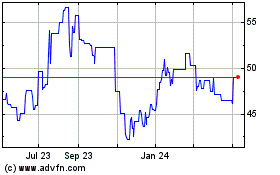By Denise Roland
One of Abbott's latest drug launches is a fruit-flavored gummy
bear containing a laxative for children with sluggish bowels.
But the bears won't be appearing in any U.S. pharmacies: They
were developed exclusively for the emerging markets, rolling out in
Russia, Eastern Europe, the Middle East and Africa.
The product, known as Duphabears, is part of Abbott's big shift
three years ago toward "branded generics," essentially off-patent
medicine launched with the sort of brand name and marketing more
typical of a patented drug. In many cases, the drugs are aimed
squarely at fast- growing markets like Eastern Europe, the Middle
East and Latin America.
The sector isn't one of Big Pharma's highest-profile businesses,
though most generic drug giants make branded generics in one form
or fashion. The category has long been caught somewhere in between
the industry's two bigger, core businesses: patented medicines,
which drug firms spend heavily both developing and then marketing;
and generics, where they do little of either.
Still, branded generics have given Abbott and a handful of other
players a relatively cheap font of growth -- allowing them to
repackage off-patent drugs and extend their commercial
lifespan.
Novartis AG's generic drug arm Sandoz, Valeant Pharmaceuticals
Inc. and India's Sun Pharmaceutical Industries Ltd. are among the
big drugmakers that also sell them.
They require much less of the expensive research and development
that goes into prescription drugs. Abbott and others can tweak
things like how the medicine is delivered -- for instance, in
liquid form or in gel caps -- for relatively little.
Branded generics, while much cheaper than patented medicines,
can command higher prices than their unbranded counterparts in the
developing world. In richer countries, pharmacists, insurers and
health-plan administrators tend to guide patients toward cheaper
generics, regardless of the brand's supplier or manufacturer. But
in poorer countries -- where government budgets are strained and
health-care infrastructure spotty -- spending for medicine tends to
come mostly out of a patient's pocket. That gives them discretion
to shell out on brands they trust.
Sales are "very much driven by promotion," says Susan Ringdal,
head of corporate strategy at U.K.-based Hikma Pharmaceuticals PLC,
which sells branded generics in the Middle East and North
Africa.
"Frankly speaking, people here spend very, very much money on
medicine," said Natalia Kosheleva, a Moscow-based pharmacist.
All that can translate into fatter margins. The Hikma division,
which sells mostly branded generics, boasts margins of around
18.4%, versus 6.9% for its unbranded oral generics business. Abbott
made an operating margin of 18.7% on its branded generics business
last year, according to Wall Street Journal calculations.
In India, branded generics accounted for about 63% of all drug
sales by value in 2015, according to Unmesh Lal, a health care
specialist at consultancy Frost & Sullivan. In China, that
figure stands at 55%. In the U.S., by contrast, branded generics
only comprise around 11% of all drug sales.
QuintilesIMS, a market intelligence firm, expects branded
generics sales to grow at an annual rate of 9%-12% over the next
five years, versus 3%-6% for both patented drugs and unbranded
generics. By 2021, it expects the branded generics market to be
worth around $323 billion, compared with around $823 billion for
patented drugs and $176 billion for unbranded generics.
The sector isn't for everyone. Emerging markets can be volatile:
Abbott last year took a $480 million write-down on currency
exchange losses related to its business in crisis-torn Venezuela.
Drugmakers that focus on innovative medicines largely stick to
marketing their old, off-patent brands in the emerging markets
rather than developing new branded generics.
What's more, many expect governments around the world to raise
regulatory standards, adding to costs, while local competition is
forecast to increase.
"I don't expect the growth we've seen in the past will carry on
unfettered," said Hikma's Ms. Ringdal.
Abbott, once one of the world's biggest prescription-drug
pharmaceutical firms, has made branded generics a priority since
slimming down four years ago. In 2013, it spun off its patented
medicines business into what is now AbbVie Inc. and two years later
sold its developed-market generic drugs business to Mylan NV.
That has left a drugs business focused on emerging markets. It
has snapped up a string of well-known, local, branded generic
drugmakers, such as Russia's Veropharm and Chile's CFR Pharma.
Abbott still makes medical devices, diagnostics and nutritional
supplements for sale across the globe.
Its own drug-development pipeline is now strictly branded
generics, too. Big sellers include Duphaston for menstrual
disorders and ibuprofen brand Brufen. Both are sold in dozens of
countries across the emerging market.
Last year, Abbott's drug sales grew 10.5%, excluding currency
fluctuations, to $3.9 billion last year, a rate of growth that beat
out most of its pharmaceuticals competitors.
"It's hard to find that with any business of scale," says
Barclays analyst Matthew Taylor.
Duphabears' main constituent is a decades-old laxative called
lactulose. Abbott has for years sold a syrup version of lactulose
under the brand name Duphalac. It developed the gummy-bear
reformulation after parents, doctors and pharmacists in several
emerging markets told its market researchers that children didn't
like the taste of the syrup.
Abbott doesn't disclose its development costs, but Barclays
analyst Doug Tsao estimates that branded generics require a few
million dollars to develop, versus the hundreds of millions that go
into bringing a completely new, patented drug to market.
"I think of innovation as everything outside the molecule," said
Todd Chermark, Abbott's head of innovation and development for the
emerging markets.
Abbott ran online and TV advertisements and hired a sales force
to promote Duphabears to doctors and pharmacists.
Ms. Kosheleva, the Moscow pharmacist, started selling Duphabears
three months ago after a visit from Abbott sales
representatives.
"I heard something about these bears," said Muscovite mom
Shakhnoza Usmanova, who gives her 5-year-old son liquid Duphalac to
deal with constipation. "If our pediatrician tells me they're good,
well, I'll probably start giving it to my boy."
--Olga Padorina in Moscow contributed to this article.
Write to Denise Roland at Denise.Roland@wsj.com
(END) Dow Jones Newswires
October 23, 2017 08:25 ET (12:25 GMT)
Copyright (c) 2017 Dow Jones & Company, Inc.
Hikma Pharmaceuticals (PK) (USOTC:HKMPY)
Historical Stock Chart
From Dec 2024 to Jan 2025

Hikma Pharmaceuticals (PK) (USOTC:HKMPY)
Historical Stock Chart
From Jan 2024 to Jan 2025
